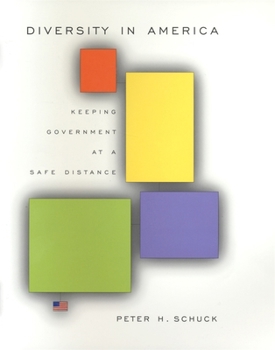Diversity in America: Keeping Government at a Safe Distance
Select Format
Select Condition 
Book Overview
America is the first society in history to make ethno-racial diversity an affirmative social ideal rather than viewing it as a fearful menace, as almost all other societies still do. Since the 1960s, America has pursued this ideal in many forms--not only to remedy past discrimination against minorities but also to increase diversity for its own sake.
It is high time for an accounting. How diverse are we now and what can we expect in the future? Why do we, unlike the rest of the world, think that diversity is desirable and that more of it is better? What risks does diversity pose? What are the roles of law, politics, and informal social controls in promoting diversity? How can we manage diversity better? In this magisterial book, Peter H. Schuck explains how Americans have understood diversity, how we came to embrace it, how the government regulates it now, and how we can do better. He mobilizes a wealth of conceptual, historical, legal, political, and sociological analysis to argue that diversity is best managed not by the government but by families, ethnic groups, religious communities, employers, voluntary organizations, and other civil society institutions. Analyzing some of the most controversial policy arenas where politics and diversity intersect--immigration, multiculturalism, language, affirmative action, residential neighborhoods, religious practices, faith-based social services, and school choice--Schuck reveals the conflicts, trade-offs, and ironies entailed by our commitment to the diversity ideal. He concludes with recommendations to help us manage the challenge of diversity in the future.Format:Paperback
Language:English
ISBN:0674018540
ISBN13:9780674018549
Release Date:February 2006
Publisher:Belknap Press
Length:462 Pages
Weight:1.30 lbs.
Dimensions:1.2" x 5.8" x 8.9"
Customer Reviews
2 ratings
The definitive work, but as such a labor to read
Published by Thriftbooks.com User , 22 years ago
Diversity is a vaporous concept, widely embraced because it sounds good, seldom defined and used as a stalking horse for a vast multitude of ends. Some such ends are achievable and others not. Many are not worth the financial and costs of achieving them, and some ends are not even honorable.Schuck performs the great service of offering definitions of the diverse collection of societal objects that comprise diversity itself. From the top, there is observed diversity. America has always been a diverse country, made up of different peoples, languages, religions and customs. In our sometimes ignoble past we attempted to limit that diversity by immigration laws, Jim Crow and other means. Nevertheless, the founders recognized the diversity that existed and seemed to promote it as an antidote to any specific group's ability to amass excessive power.The metric of diversity means different things to different groups. It most often means visible diversity by skin color, the "ethno-racial pentagon" of Caucasian, African, Native American, Asian and Latin American peoples. Crudely put, white, black, red, yellow and brown. Schuck points out that this photographically demonstrable diversity along the single axis of ethnic origins often hides a stunning uniformity of political liberalism and religious (un)belief. Diversity in schools has to be taken to mean a diversities in ability to learn and therefore the amount of resources needed to enable a student to realize a given level of achievement. And, for that matter, just to maintain order. Diversity as a starry-eyed ideal is peculiar to 20th century America and Canada. That is to say, one never saw "Celebrate Diversity" bumper stickers on Conastoga wagons. As they dodged the arrows of diverse populations. The particulars of timing are different depending on whether one is talking about religious or racial diversity or multiculturalism. Since before the Revolution many elements of our diverse society had been revulsed by the exclusion of African Americans from education and mainstream society. With the civil rights movement diversity came to be seen not only as an indication of legal equity in society but as a desirable end in itself. A norm of society. Our society has used many devices to advance the cause of racial diversity. Conscience is one. Universities and corporations adopted diversity programs because their leadership deemed it the right thing to do. Guilt is another, remedying past discrimination. A third is common business sense. A company that sells to a diverse clientele should present a diverse face to the public. Schuck gives greatest attention to a fourth, legislative and judicial efforts to force diversity in the realms of educational and corporate affirmative action, immigration, multiculturalism and housing. He follows the legal proceedings in exhaustive detail.Schuck's bottom line is that "government... should use its bully pulpit to praise diversity in general and eve
The range and intergity of a great mind and a great person
Published by Thriftbooks.com User , 22 years ago
Peter Schuck's remarkable book will become a classic. He gently, humbly, and with the intellectual penetration of a great mind approaches the delicate subject of our country's remarkable diversity (an historical anomaly, he notes.) Professor Schuck shows no fear or favor, and his book will contribute to our national conversation on diversity by asking many questions which have been unanswered by the many actors in American political life interested in affirmative action, religion, immigration and other diversity-related subjects. Hang on - something you took for granted will be questioned.






